The heart of many laser applications lies in the efficient and precise control of the laser diode. For continuous-wave (CW) lasers, the driver plays a crucial role in providing the necessary power and current to operate the diode at its optimal performance. This article will delve into the intricacies of driver for a CW laser diode, exploring its function, key characteristics, and the factors influencing its selection for different laser applications.
Understanding CW Laser Diodes and Their Drivers
CW laser diodes emit a continuous beam of light, unlike pulsed lasers that generate light in short bursts. These diodes require a stable and regulated current supply to maintain a constant output power. This is where a driver for a CW laser diode steps in, acting as a crucial intermediary between the power source and the diode.
The Role of a Driver in CW Laser Operation
A driver for a CW laser diode serves several critical functions:
- Current Control: The driver ensures a precise and stable current flow through the diode. This is essential for maintaining a consistent laser output power.
- Voltage Regulation: The driver regulates the voltage applied to the diode, preventing damage due to excessive voltage.
- Temperature Control: Some drivers incorporate temperature control mechanisms to regulate the diode's temperature and ensure stable operation.
- Protection Mechanisms: Drivers often include features like current limiting, overvoltage protection, and short circuit protection to safeguard the diode from damage.
Key Characteristics of CW Laser Diode Drivers
Selecting the right driver for a CW laser diode involves considering several key characteristics:
- Current Output: The driver's maximum current output must be sufficient to operate the chosen diode at its desired power level.
- Current Stability: The driver should provide a stable and ripple-free current to ensure consistent laser output.
- Voltage Output: The driver's output voltage must be compatible with the laser diode's requirements.
- Temperature Stability: For applications sensitive to temperature fluctuations, drivers with temperature control mechanisms are essential.
- Power Efficiency: Efficient drivers minimize power loss, reducing heat generation and improving overall system performance.
Factors Influencing Driver Selection
The choice of a driver for a CW laser diode is dictated by several factors, including:
- Laser Diode Type: Different types of CW laser diodes have varying operating parameters, such as current and voltage requirements.
- Laser Application: The specific application, such as optical communication, laser marking, or medical imaging, influences the driver's characteristics.
- Power Level: The required laser output power dictates the driver's current and voltage capabilities.
- Operating Environment: Factors like temperature variations, humidity, and vibration can affect driver performance.
- Cost and Size: Budget constraints and space limitations often play a role in driver selection.
Types of CW Laser Diode Drivers
Drivers for a CW laser diode are available in various configurations, depending on the specific requirements of the application.
- Linear Drivers: These drivers use a linear circuit to regulate the current and voltage. They are relatively simple but may have lower efficiency.
- Switching Drivers: Switching drivers utilize a switching regulator for improved efficiency and often feature smaller sizes.
- Analog Drivers: These drivers are typically used in applications requiring fine-tuning of the laser power, and offer precise control over the current output.
- Digital Drivers: Digital drivers provide advanced features like programmable current and voltage settings, as well as monitoring and control capabilities.
Conclusion
The driver for a CW laser diode is an indispensable component for achieving optimal laser performance. Understanding the driver's role, key characteristics, and factors influencing its selection is crucial for successful CW laser applications. By carefully considering the specific needs of the application and choosing a suitable driver, researchers and engineers can ensure reliable and efficient operation of their CW lasers.
